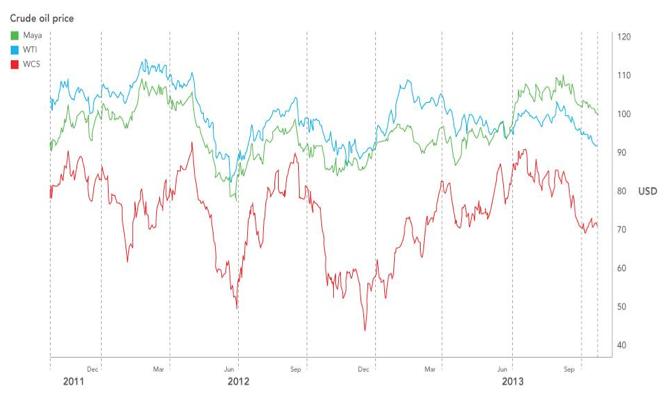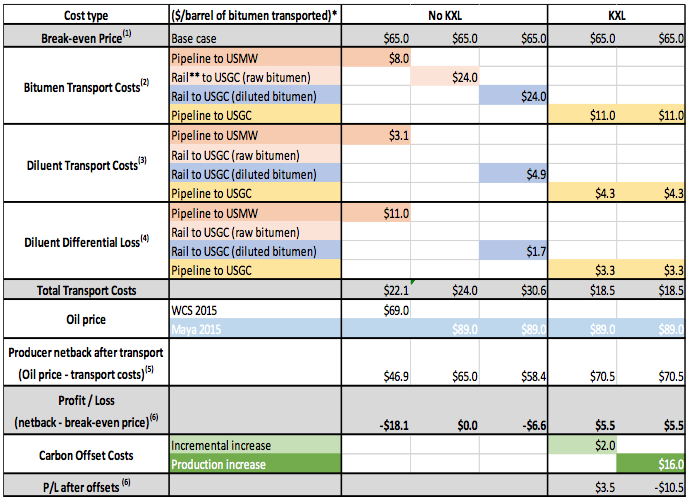An analysis of the economics of Canada's oil sands by Carbon Tracker Initiative examines how Keystone XL (KXL) will impact the economics of Canada's oil sands. Canada's oil sands producers have long regarded KXL (or its alternative, the Northern Gateway Pipeline) as the panacea to the problem with high price differentials, currently in the 40 percent range between oil sands-sourced oil and conventional oil (West Texas Intermediate).
As background, Canada's oil sands producers have rather ambitious expansion plans. From a production level of 1.8 million BOPD in 2012, production from oil sands is expected to rise to 2.3 million BOPD in 2014, 4.5 million BOPD in 2020 and 5.2 million BOPD in 2025. Here is a graph showing the ramping up of production from 2012 to 2030:
One of the biggest problems facing Canada's oil sands producers is the infrastructure bottleneck that prevents oil from flowing to the United States Gulf Coast. This is creating local gluts of oil, pushing prices for Western Canadian Select well below the price for the benchmark West Texas Intermediate as shown on this graph (with WCS in red):
The proposed KXL pipeline will link Alberta with the United States Gulf Coast, allowing oil companies to export an additional 830,000 BOPD of which 730,000 BOPD would be available for oil sands production and 100,000 BOPD would be available for tight oil plays in the Williston Basin (i.e. the Bakken). The KXL pipeline would provide:
1.) A direct link to the Gulf Coast which would provide oil sands producers a price improvement (a reduction in the differential) since the oil sands oil (Western Canadian Select or WCS) is closer in quality to Mexican Maya which trades closer to the price of West Texas Intermediate (WTI).
2.) The pipeline will relieve the pressure on existing export routes, allowing prices on WCS to rise in the Midwest.
Now that we have some background information, let's look at CTI's analysis. As we know, the producing costs for much of Canada's oil sands are at the upper end of the upper quartile of the world's oil production cost curve. In-situ or steam-assisted-gravity-drainage (SAGD) methods are the least costly, followed by non-upgraded mining production and projects with integrated mining operations and upgraders being the most expensive (i.e. Syncrude/Suncor). Data from several analysts suggests that the break-even oil price required to make an oil sands project economic range from $60 to $100 per barrel with SAGD projects having a break-even price of $65 to $85 per barrel. Here is a graphic showing the cost curves for some of the key new oil projects around the world with Canada's heavy oil sands projects in red:
As I noted above, the cost to produce a barrel of heavy Canadian oil ranges from about $52 per barrel to about $93 per barrel, depending on the project.
Here is a chart showing the outcome at a price of $69 per barrel for WCS and a price of $89 per barrel for Mexican Maya, both in 2015, assuming a break-even price of $65 per barrel assuming a 10 percent discount rate:
Please note that profit/loss is measured after producer netback post-transportation less the break-even price of $65 per barrel. The break-even price is the price per barrel required to cover all costs and provide the oil company involved with the rate of return (in this case, 10 percent) that it requires to proceed with a project. It is highly likely that this break-even price will rise over time; it already appears that the break-even price for some projects may be in excess of $80 per barrel.
Without KXL, each barrel of WCS produced loses $18.10. With KXL, profit rises to $5.50 per barrel. With an incremental carbon offset cost of $2.00 per barrel, producers will see a net of $3.50 per barrel, a rather skinny profit margin. Using a $65 per barrel initial cost and assuming that there are minimal carbon offset costs, KXL can shift projects from being unprofitable to being marginally profitable provided that refiners on the Gulf Coast are willing to pay the same price for WCS as they do for heavy Mexican Maya crude.
There are risks associated with this scenario:
1.) The demand for Canadian crude could drop as United States oil production rises (i.e. the Bakken) and more energy efficient vehicles reduce demand. United States imports of crude oil and products have already dropped from 12 million BOPD in 2007 to 7 million BOPD in 2012.
2.) Competitive pressures from imports of WCS could depress the price of Mexican Maya as PEMEX (Mexico's state oil company) seeks to maintain its market share by lowering prices.
3.) KXL could create a production cost inflation as development of new oil sands projects creates additional shortages of materials and labour. If the cost of production were to rise by as little as 10 percent, this would push profits down by $6.50 per barrel in the analysis noted above.
4.) Highly volatile oil pricing could easily affect profitability.
5.) An increase in the desired rate of return will negatively impact the break-even point.
To summarize, if investors automatically assume that the green lighting of the Keystone XL pipeline will mean huge returns to shareholders, perhaps they should think twice. Unless it appears that the world's oil markets will sustain their current price scenario over the long-term, the economics of expanding Canada's oil sands industry looks like it could well be marginal at best.
Click HERE to read more of Glen Asher's columns
You can publish this article on your website as long as you provide a link back to this page.





Be the first to comment